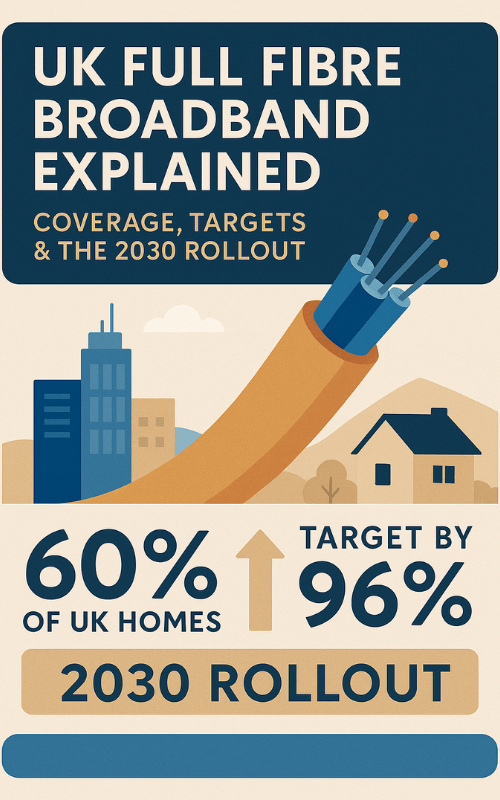Full Fibre Broadband UK 2025: Coverage, Targets & Rollout

Here’s the thing: everyone’s talking about “gigabit broadband”, but most people still have no idea what full fibre really means for them.
In 2025, over 60% of UK homes will have access to full fibre, with Openreach leading a massive expansion across towns, cities, and rural communities. The government is targeting 96% coverage by 2030, and billions are being poured into the so-called “Gigabit Scheme.” Sounds impressive, right?
But here’s the reality: coverage numbers don’t tell the whole story. Some areas are racing ahead, others are still waiting, and even where fibre is technically “available,” adoption lags. That’s why so many people are asking:
- Is Openreach really expanding to 17 million premises?
- Will the UK go fully fibre by 2030?
- Who’s the biggest provider?
- And does everyone actually need gigabit speeds?
This guide answers all of those questions, with stats, clear explanations, and practical takeaways. We’ll cover targets, timelines, percentages, schemes, providers, and even myths like “Will 6G replace fibre?”
Because full fibre isn’t just jargon. It’s the backbone of the UK’s digital future, and it will shape how we work, stream, and connect for decades to come.
Is Openreach Expanding Full Fibre to 17 Million Premises?
Short answer: yes, and they’re already past that milestone.
Openreach, the infrastructure arm of BT, is leading the UK’s full-fibre revolution. By early 2025, they’d connected over 17 million premises to fibre-to-the-premises (FTTP). Their long-term target? 25 million homes and businesses by December 2026.
This rollout is happening at breakneck speed, with Openreach passing an average of 60,000 new premises every week. Towns like Milton Keynes, Salisbury, and Ipswich were among the first “full fibre cities,” but now the build is extending into smaller towns and rural communities.
Why does this matter? Because Openreach controls the wholesale fibre network that powers many UK providers, from BT and Sky to TalkTalk and Plusnet. That means when Openreach expands, millions of consumers instantly benefit.
If you’re curious about packages available through Openreach’s network, check our BT Broadband provider page, which breaks down the latest offers.
But Openreach isn’t the only player in the game. Alt-nets like Community Fibre, Hyperoptic, and CityFibre are racing to fill gaps, often in areas where Openreach is slower to move. (We’ll cover them later in this guide.)
Bottom line: Openreach’s expansion to 17 million premises is just the start. With their target of 25 million by 2026, they’ll remain the single biggest force in making full fibre the UK’s new default.
What % of the UK Has Full Fibre in 2025?
As of 2025, just over 60% of UK homes and businesses have access to full fibre broadband. That’s a massive leap from just 10% in 2019, and it shows how fast the rollout has accelerated.
But here’s where it gets tricky: coverage is not evenly spread.
- Urban hubs like London, Birmingham, and Manchester enjoy 90%+ fibre availability.
- Rural areas, think remote villages in Wales, the Scottish Highlands, or parts of Northern Ireland, are still well below the national average. Some households remain stuck on copper or satellite alternatives.
- Islands and smaller jurisdictions are mixed, but places like Guernsey have become fibre success stories. We’ve tracked that story in Guernsey’s Fibre Broadband Future and the latest on Guernsey Improved Internet.
And while gigabit coverage (including Virgin Media’s hybrid network) now hits over 86%, not all of that is full fibre. The numbers sound similar, but “gigabit-capable” doesn’t always mean the same reliability or future-proofing as true fibre-to-the-premises (FTTP).
So, what does this mean for you? It means you can’t just rely on the national stats. You need to check your own postcode to know what’s available at your address. Our Broadband Deals Near Me tool is the quickest way to find out whether your home is already part of the fibre revolution.
Bottom line: more than half the country is fibre-ready, but whether your street is connected still depends heavily on location.
What Is the UK’s Target for Full Fibre?
The UK government has set one of the most ambitious broadband goals in Europe: 96% full-fibre coverage by 2030.
That means almost every home and business should have fibre-to-the-premises (FTTP) available within the next five years. The policy is part of the £5 billion Gigabit Project, which funds rural rollouts and ensures fibre doesn’t just stop at the edges of profitable cities.
Sounds great, right? Here’s the catch: hitting coverage targets is one thing, getting people to actually switch is another. Ofcom’s data shows that millions of homes that have already been passed by fibre haven’t been upgraded. Why? Cost, lack of awareness, or simply not understanding the benefits.
This is why regulation plays a huge role. Ofcom has been tasked with keeping rollout fair and prices transparent. We covered this in:
If the UK is serious about its 2030 target, it’s not just about cables in the ground. It’s about adoption, affordability, and confidence. Without tackling those, millions of households risk being left out, even if fibre technically reaches their postcode.
Bottom line: the 2030 full-fibre target is bold and achievable. But it will only succeed if rollout, regulation, and consumer adoption all move in sync.
Will the UK Have Full Fibre Broadband by 2030?
On paper, the answer is yes. By 2030, the government expects 96% of the UK to be covered by full fibre. Openreach alone is on track for 25 million premises by 2026, and Virgin Media O2, CityFibre, and dozens of alt-nets are filling in the rest.
But here’s the reality check: coverage is not the same as adoption.
Even today, millions of homes that have already passed by fibre haven’t switched. Some stick with copper because it “works fine.” Others avoid fibre because of price, confusion, or lack of confidence in switching. That’s why digital inclusion is the bigger challenge for 2030, not just laying cables, but ensuring households actually connect.
Affordability will be the main sticking point. As we’ve seen in our Affordable Broadband Solutions for Seniors and Best Providers for Low-Income Households, vulnerable groups remain at risk of being left behind.
And then there’s confidence. Many older adults still see fibre as complicated or unnecessary. Our Broadband for Pensioners Made Easy guide breaks down how simple fibre really is, but awareness is key.
Bottom line: by 2030, fibre will almost certainly be available everywhere. The real question is whether every household will actually adopt it. Without stronger action on price and education, the UK risks becoming a nation of “fibre haves and have-nots.”
Is the UK Going Full Fibre?
The short answer: yes, the UK is going full fibre.
The copper network that’s powered landlines and broadband for decades is being phased out. By 2027, traditional landline services will be fully switched off. After that, every UK connection will run over digital lines, with full fibre as the backbone.
This transition is already happening. Areas like Salisbury and Mildenhall were the first to trial “all-fibre” living, and thousands of households have already been migrated off copper. For many, the change was seamless, but for others, it raised questions about reliability, compatibility with alarm systems, and even how older residents adapt.
We’ve broken this down in detail in:
Going full fibre isn’t just about faster streaming. It means better stability, lower latency, and future-proof infrastructure that can handle AI-driven devices, smart homes, and next-gen cloud services.
Bottom line: the UK is already on the path to going full fibre. By the end of the decade, copper will be history, and fibre will be the new normal for every household and business.
What Is the Gigabit Scheme in the UK?
The UK Gigabit Scheme is the government’s £5 billion plan to make sure rural and hard-to-reach areas don’t get left behind in the fibre rollout.
Here’s how it works:
- The scheme funds vouchers for households and small businesses in areas where commercial rollout isn’t happening fast enough.
- These vouchers help cover the installation cost of fibre connections, making it financially viable for providers to build in remote postcodes.
- Priority is given to rural communities, schools, GP surgeries, and small businesses that rely on connectivity for daily operations.
So far, tens of thousands of homes have already benefited, and the scheme is expected to scale massively through 2026. But there’s a catch: eligibility depends on where you live, and not everyone qualifies.
That’s why checking your postcode is essential. Our Broadband Deals Near Me tool helps you see what’s already available in your area. If fibre hasn’t reached you yet, explore short-term solutions in our No Contract Broadband Solutions guide, so you’re not stuck waiting.
The scheme also supports “community builds,” where entire villages pool vouchers together to attract providers. We’ve seen rural Wales and the Scottish Highlands benefit most from this approach.
Bottom line: the Gigabit Scheme is the safety net of the UK’s fibre rollout, making sure the final 20% of the country gets connected, not just the profitable postcodes.
FAQ Round-Up
We’ve unpacked the big questions around the UK’s full fibre rollout, but let’s tackle the ones people ask Google every day.
What Are the Disadvantages of Gigabit Internet?
Gigabit broadband is lightning fast, but most households don’t fully use it. The main drawbacks are higher monthly costs and the fact that your own devices (old laptops, outdated routers) may bottleneck speeds. For many, a solid 100–300 Mbps plan is more than enough. See our Boost Broadband Speed Guide if you’re not hitting the speeds you pay for.
Will 6G Replace Fibre?
No. 6G (when it arrives) will be wireless, but it won’t replace fibre. Instead, it will complement fibre, offering mobility and flexibility while fibre delivers the backbone of stable, high-capacity networks. Want to know how 5G is evolving? Read our 5G Networks Future.
Who Is the Largest Fibre Provider in the UK?
That crown goes to BT Openreach, which serves as the backbone for providers like BT, Sky, TalkTalk, and Plusnet. Virgin Media is the biggest competitor, covering over 15 million premises, but much of its network is still hybrid. Curious? Check out:
Conclusion: Your Fibre Future
By 2030, the UK will be a full-fibre nation on paper. But for consumers, the story isn’t about coverage maps or government targets; it’s about making the right choice for your household.
>>Ready to see what’s live in your area? Start with Broadband Deals Near Me.
>>Want to compare the best offers side by side? Use our Compare Broadband Deals.
Bottom line: full fibre is the backbone of the UK’s digital future, but whether you benefit depends on one thing: making the switch. Don’t just wait for 2030. Check your options today and take control of your connection.



